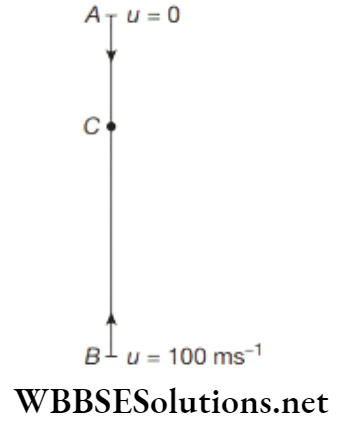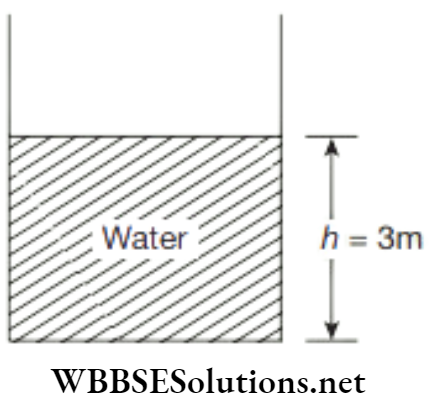Chapter 3 Gravitation
In our day to day life, we see that objects get attracted towards earth. When we throw a ball up in the air, it comes back towards earth. It means there is some force that compels objects to return back towards earth. This force is known as gravitational force. Gravitational force is a natural phenomenon where all objects having energy attract towards each other.
For example, stars, planet, sun, etc. Gravity is considered as the weakest among the four fundamental interactions of nature. The four fundamental interactions (fundamental forces) are gravitational, electromagnetic, strong nuclear and weak nuclear.
Due to gravitational force, earth and other planets are revolving around the sun in different orbit. In this chapter, we will understand about the gravitational force and its details.
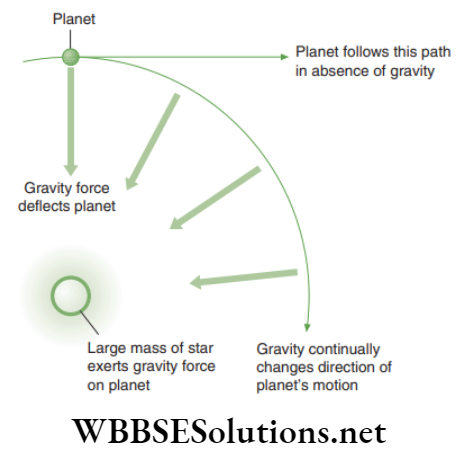
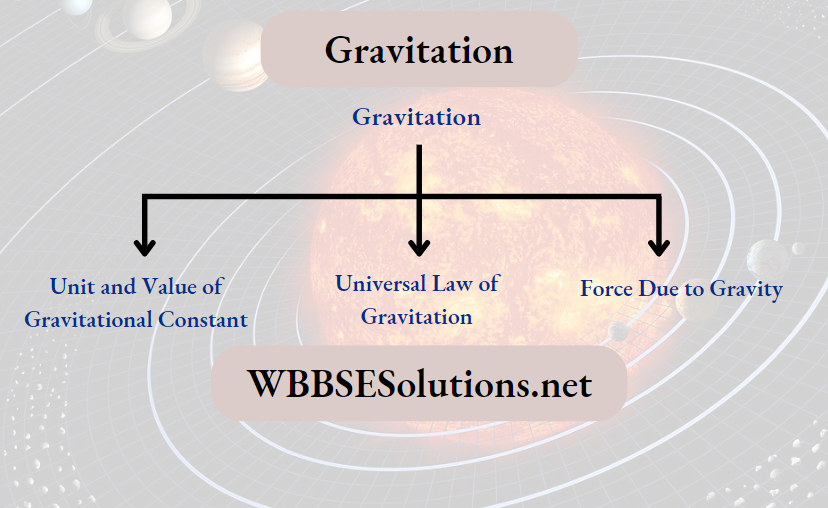
Chapter 3 Gravitation
Gravitation is a natural phenomenon in which two objects having masses attract each other. We have studied that the moon revolves around the earth and the earth revolves around the sun. There are also other planets other than earth that rotate around the sun. The reason why planets revolve around the sun and why does not it go straight towards the sun is due to gravitational force.
Read and Learn More: NEET Foundation Notes
In 628, Brahmagupta, an Indian astronomer recognised gravity as a force of attraction. In 1600’s, Galileo Galilei, Robert Hooke and Johannes Kepler formulated the laws of gravity near the earth.
While studying about the orbits of planets around the sun, Kepler determined that gravitational attraction varied with the separation and thus formulated his laws of planetary motion.
In 1687, Isaac Newton worked on planetary motion and its empirical measurements. His study established the law of universal gravitation.
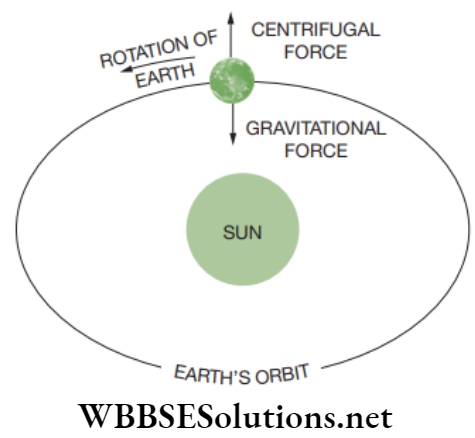
Universal Law of Gravitation
As we know, each particle of universe attracts the other particle. The force of attraction between two particles due to their masses is called gravitational force of attraction. Sir Issac Newton gave the law ‘Newton’s universal law of gravitation’ for its magnitude.
According to Newton, gravitational force of attraction (F) between two particles is:
- Directly proportional to the product of their masses
i.e., F ∝ m1m2
- Inversely proportional to square of the distance between them
i.e., \(F \propto \frac{1}{r^2}\)
Combining both the equations,
\(F \propto \frac{m_1 m_2}{r^2}\)
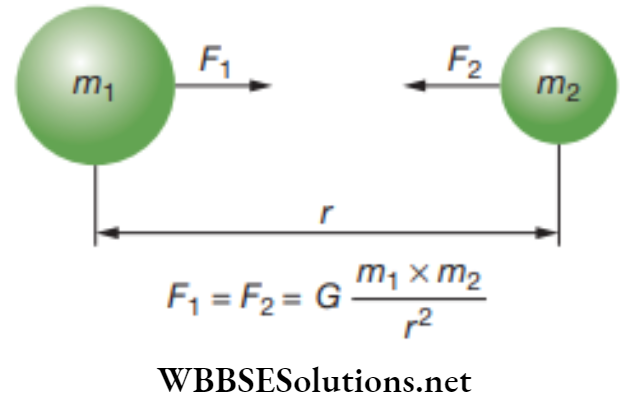
\(F=G \frac{m_1 m_2}{r^2}\)
where G = constant of proportionality known as gravitational constant.
The value of G is same at all places and is not dependent on the nature of particles, temperature, medium and so on. Therefore, it is a universal constant and is therefore known as “universal gravitational constant”.
Unit and Value of Gravitational Constant
G = \(\frac{F \times r^2}{m_1 \times m_2}\)
\(\text { S.I. unit of } G=\frac{\text { Newton } \times \text { metre }^2}{\text { kilogram } \times \text { kilogram }}\)
= Nm2/kg2
Value of G = 6.67 × 10-11 N m2/kg2
If m1 = 1 kg, m2 = 1 kg, r = 1 m, then G = F
Therefore, G can be defined as:
Gravitational constant ‘G’ is numerically equal to the gravitational force of attraction between two masses, each of mass 1 kg placed at a distance of 1 m.
Gravitational force between two masses is:
- Always attractive.
- Directly proportional to the product of the masses.
- Inversely proportional to the square of separation between them.
- Significant between heavenly bodies but is insignificant between ordinary bodies because of small magnitude of G.
Kepler’s Law of Planetary Motion
Newton’s law of motion which state’s that the gravitational force between two masses varies inversely proportional to the square of the distance between them was proved by him on the basis of Kepler’s law of planetary motion.
There are three laws which explain the motion of planets. These laws are called Kepler’s law. They are:
1. Law of orbit: This is the 1st law of planetary motion which states that each planet moves around sun in an elliptical orbit with the sun at one of the foci of the orbit. This can be shown by the below image.

2. Law of areas: This is the 2nd law of Kepler which states that the line joining the sun and planet sweep out equal areas in equal interval of time. It means velocity of the planet around the sun is not constant. In the figure below the sun is at S, which is one of the foci of the elliptical orbit. If the time of travel of planet from P1 to P2 is same as that of P3 to P4, than according to this law, Area of OP1P2 = Area of OP3P4
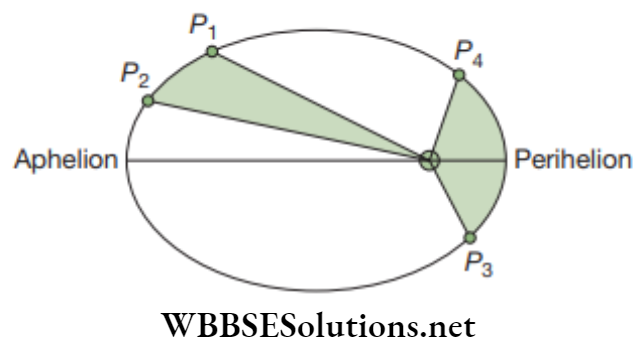
Therefore arc P1P2 is smaller than arc P3P4. This means that the speed of the planet is greater when it is closer to the sun, than its speed when it is farther away from the sun.
3. Law of periods: The square of the time taken by a planet to complete a revolution around the sun is directly proportional to the cube of semi major axis of the elliptical orbit. This is the third law of Kepler’s planetary motion.
i.e., T2 ∝ r3
Or T2 = constant × r3
i.e., T2/r3 = constant
Importance of Universal Law of Gravitation
The universal law of gravitation is important because it is:
- The force that binds us to the earth
- The motion of the moon around the earth
- The motion of planets around the Sun
- The tides due to the moon and the Sun
Characteristics of Gravitational Force
- Gravitational force acts at distance. It means it does not need any contact between the two objects or bodies.
- Gravitational force between the two bodies varies inversely proportional to the square of the distance between them
- Gravitational force between two bodies forms action reaction pair.
Chapter 3 Gravitation Very Short Question and Answers
Question 1. Why planets revolve around the sun?
Answer:
Planets revolve around the sun:
The planet revolve around the sun and not straight into it is because of gravitational motion.
Question 2. What is Universal law of gravitation?
Answer:
Universal law of gravitation:
According to Newton, the gravitational force acting between two bodies is directly proportional to the product of their masses and inversely proportional to the square of distance between their centres.
Question 3. Define gravitational constant.
Answer:
Gravitational constant:
Gravitational Constant ‘G’ is numerically equal to the gravitational force of attraction between two masses, each of mass 1 kg placed at a distance of 1 m.
Question 4. Describe the importance of Universal law of gravitation.
Answer:
The importance of Universal law of gravitation:
Universal law of gravitation is important because it is:
The force that binds us to the earth.
The motion of moon around earth.
The motion of planets around the Sun.
The tides due to moon and sun.
Question 5. A Saturn year is 29.5 times the earth year. How far is Saturn from the sun (M) if the earth is 1.5 × 108 km away from the sun?
Answer:
Given:
A Saturn year is 29.5 times the earth year.
it is given that
TS = 29.5 Te
Re = 1.5 × 1011 m
Now, according to Kepler’s third law
TS2/Te2 = Rs3/Re3
RS = Re (TS/Te)2/3 = 1.5 × 1011 ((29.5Te)/Te)2/3
= 1.43 × 1012 m
= 1.43 × 109 km
Chapter 3 Gravitation Free Fall
Any object that falls towards the earth is said to be in free fall. This happens due to gravitational force. On falling there is no change in the direction of motion of the objects but because of the earth’s attraction, there will be a change in magnitude of the velocity. Change in velocity causes acceleration.
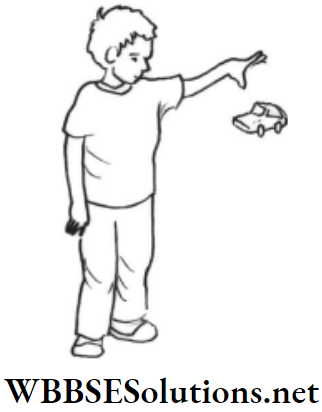
Motion of Objects Under the Influence of Gravitational Force of the Earth
The acceleration of a vertically falling object (a) = +g
The acceleration of an object vertically thrown up (a) = –g
If an object falls from rest freely under gravity from a height h, u = 0 and acceleration a is replaced by g then
v = gt
s = \(\frac{1}{2} g t^2\)
v2 = 2gh
If a body is thrown vertically downwards with an initial velocity u, then
v = u + gt
s = \(u t+\frac{1}{2} g t^2\)
v2 = u2 + 2gh
If an object is thrown vertically up with an initial velocity u, there will be retardation i.e. a = –g. Then, equations will be
v = u – gt
s = \(u t-\frac{1}{2} g t^2\)
v2 = u2 – 2gh
When the thrown object reaches its highest point, its final velocity v = 0, therefore
Maximum height hmax = \(\frac{u^2}{2 g}\)
Time taken to reach the highest point t = \(\frac{u}{g}\)
Object comes back to the earth in the same time t, therefore total journey time t’ = 2t = \(\frac{2 u}{g}\)
Total distance travelled by the object, h’ = 2 hmax = \(\frac{u^2}{g}\)
Force Due to Gravity
The force with which the earth attracts an object is called force due to gravity on the object. It always acts vertically downwards at the centre of gravity of the object. In vertical motion near the earth surface, the force of gravity of an object is assumed to be same throughout, assuming that the change in height of the object is much smaller than the radius of earth.
The force due to gravity on an object (with mass m) kept on the surface of the earth (mass is M and radius is R) is equal to the force of attraction between the earth and the object.
Equation
F = \(\frac{G M m}{R^2}\)
Let us assume M = 5.96 × 1024 kg
R = 6.37 × 106 m
m = 1 kg
F = \(\frac{\left(6.67 \times 10^{-11}\right) \times\left(5.96 \times 10^{24}\right) \times 1}{\left(6.37 \times 10^6\right)^2}\)
= 9.8 N
This shows that earth attracts an object of mass 1 kg by a force of 9.8 N towards its centre.
Gravitational Force between Earth and the Sun
Mass of earth, m1 = 6 × 1024 kg
Mass of sun, m2 = 2 × 1030 kg
Distance between sun and earth, R = 1.5 × 1011 m
Gravitational force between the sun and the earth,
F = \(G \frac{m_1 m_2}{r^2}\)
F = (6.67 × 10-11 Nm2 kg-2 × 6 × 1024 kg × 2 × 1030 kg)/(1.5 × 1011 m)2
F = 3.6 × 1022 N
Gravitational Force between the Moon and the Earth
Mass of earth, m1 = 6 × 1024 kg
Mass of moon, m2 = 7.4 × 1022 kg
Gravitational force between earth and the moon is
F = \(G \frac{m_1 m_2}{r^2}\)
F = (6.67 × 10-11 Nm2 kg-2 × 6 × 1024 kg × 7.4 × 1022 kg)/(3.8 × 108 m)2
F = 2.05 × 1020 N
As an object gets attracted towards the earth, similarly the earth too gets attracted towards the object. An object is free to move so it starts moving towards the earth but the earth has higher inertia therefore it does not move towards the object.
For example, when a ball is thrown from a top of a building, due to gravitational force it falls on the ground. Earth has higher inertia than the ball therefore the earth doesn’t move from its location.
Centre of Mass and Centre of Gravity
Centre of Mass is the point in body where its whole mass is assumed to be concentrated. The centre of mass of a homogeneous sphere or cube must lie at its geometrical centre. Each particle or portion of the body experiences the force of gravity. The net effect of all these forces is equivalent to the effect of a single force, mg acting through a point called centre of gravity of a body.
On the surface of the earth, or near it, where the force of gravity is constant, the centre of mass also becomes the centre of gravity.
Application of Newton’s Law of Gravitation
1. Determination of masses of planets and stars: Knowing the values of g, R and G, it is possible to determine accurately the mass of any planet or star by using relationship,
\(M=\frac{g R^2}{G}\)
2. Estimating the masses of double stars: A double star is a system consisting of two stars orbiting around their common centre of masses. From the extent of irregularity in the motion of star due to gravitational pull by some other star bound to it is used for estimating the masses of star. Such irregularity in motion is called wobble.
Acceleration due to Gravity
The scientist Galileo did analysis on the motion of different objects under the force of attraction of the earth. From his experiments, he concluded that if objects of different sizes, masses fall at the same time and from the same height in vacuum, then they will reach the earth together. It shows that objects travel the same distance in same interval of time.
He also concluded that the velocity of a freely falling object does not remain constant instead it increases at a constant rate. In other words, the motion of a freely falling object is a uniformly accelerated motion. This acceleration is same for all objects.
The acceleration of a freely falling object does not depend on the mass, size and shape of the object. This acceleration is known as acceleration due to gravity.
The rate at which the velocity ofthe freely falling objectincreases is called acceleration due to gravity. It is a vector quantity.
It is represented by g.

Unit
The S.I. unit of acceleration due to gravity is m/s2.
The value of g changes from place to place. On equator, it is slightly less as compared to that at poles. At altitudes above the earth’s surface or at depth below the earth surface value of g decreases. The value of g is zero at the centre of the earth. The mean value of g on the earth surface is taken to be 9.8 m/s2. The value of acceleration due to gravity of the earth is 9.8 m/s2
Relationship between g and G
Let g = acceleration due to gravity at a planet
M = mass
R = radius
m = mass of object
By Newton’s law of motion, force on a body due to gravity on its surface
F = mass × acceleration due to gravity
= m g
By Newton’s gravitational law, force is
F = \(\frac{G M m}{R^2}\)
Therefore,
\(\frac{G M m}{R^2}=m g\)
∴ Acceleration due to gravity
g = \(\frac{G M}{R^2}\)
i.e. acceleration due to gravity on the surface of a planet depends on its mass (M) and its radius (R).
Variation in the Value of g with Depth below the Surface of the Earth
Let us consider a body of mass m at a depth h below the surface of earth. Than radius of the inner solid sphere of the earth = R – h
Volume of the inner solid sphere of the earth = \(\frac{4}{3} \pi(R-h)^3\)
If d is the average density of the earth, then
Mass of inner solid sphere of earth = \(\frac{4}{3} \pi(R-h)^3 d\)
According to the law of gravitation,
\(m g_d=G \times \frac{4}{3} \pi(R-h)^5 d \times \frac{m}{(R-h)^2}\)
This gives
\(g_{\mathrm{d}}=G \times \frac{4}{3} \pi(R-h) d\)
On the surface of earth,
g = \(\frac{G M}{R^2}\)
= \(G \times \frac{4}{3} \pi R^3 \frac{d}{R^2}\)
= \(G \times \frac{4}{3} \pi R d\)
From equation (1) and (2)
\(\frac{g_d}{g}=\frac{\left(G \times \frac{4}{3} \pi(R-h) d\right)}{\left(G \times \frac{4}{3} \pi R d\right)}\)
= \(\frac{(R-h)}{R}\)
\(g_{\mathrm{d}}=g\left(\frac{1-h}{R}\right) \quad \text { or } \quad \frac{(R-h)}{R}<1\)
So, gd < g
Thus, the value of g at a depth inside the earth is less than that on the surface of the earth.
The value \(\frac{(R-h)}{R}\) decreases with the value of h, i.e., depth below the surface of earth. So the value of g decreases as we go down below the surface of earth.
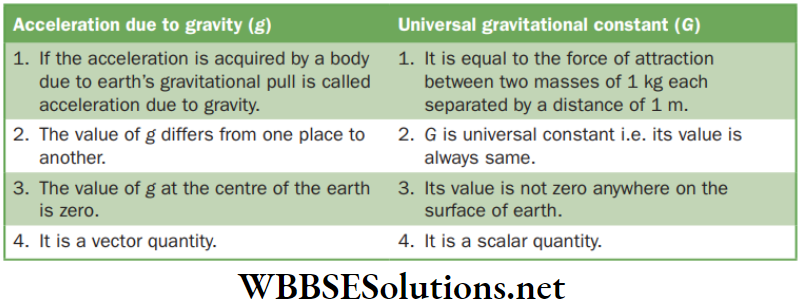
Chapter 3 Gravitation Very Short Question and Answers
Question 1. Define centre of gravity.
Answer:
Centre of gravity:
Each particle or portion of a body experiences the force of gravity. The net effect of all these forces is equivalent to the effect of a single force mg acting through a point called centre of gravity of the body.
Question 2. A sphere of mass 40 kg is attached by a second sphere of mass 15 kg when their centres are 20 cm apart, with a force of 0.1 milligram weight. Calculate the value of gravitational constant.
Answer:
Given:
A sphere of mass 40 kg is attached by a second sphere of mass 15 kg when their centres are 20 cm apart, with a force of 0.1 milligram weight.
Here, m1 = 40 kg, m2 = 15 kg
R = 20 cm = 20/100 m = 2 × 10-1 m
F = 0.1 milligram weight = 0.1 × 10-3 gram weight
F = 10-4 × 10-3 kg wt
F = 10-7 × 9.8 N (1 kg wt = 9.8 N)
F = \(G \frac{m_1 m_2}{r^2}\)
G = \(\frac{F \times r^2}{m_1 \times m_2}\)
G = 10-7 × 9.8 × (2 × 10-1)2/(40 × 15)
G = 6.53 × 10-11 N m2 kg-2
Question 3. Find the gravitational force between the two protons kept at a separation of 1 femtometer (1 femtometre = 10-15 m). The mass of a proton is 1.67 × 10-27 kg.
Answer:
Gravitational force is given by:
F = \(G \frac{m_1 m_2}{r^2}\)
= (6.67 × 10-11 Nm2 kg-2) × (1.67 × 10-27 kg)2/(10-15 m)2
= 1.86 × 10-34 N
Question 4. Define acceleration due to gravity. Write its symbol and its value.
Answer:
Acceleration due to gravity:
The rate at which the velocity of a freely falling object increases is called acceleration due to gravity. It is denoted by g and its value is 9.8 m/s2.
Question 5. What is the relationship between acceleration due to gravity (g) and Universal gravitational constant?
Answer:
Acceleration due to gravity (g) is given by
g = GM/R2
Where M = mass of the planet
R = radius of the planet
Chapter 3 Gravitation Fill In The Blanks
Question 1. The value of acceleration due to gravity __________ if we go down below the surface of earth.
Answer. Decreases
Question 2. The acceleration due to gravity depends on the mass of the object. (True/False)
Answer. False
Question 3. Centre of mass becomes the centre of gravity
- At the core of the earth
- On the surface of the earth
- Force of gravity varies
- Never happens
Answer. 1. At the core of the earth
Question 4. _____________ is the point in body where its whole mass is assumed to be concentrated.
Answer. Centre of Mass
Question 5. The value of acceleration due to gravity of the earth is ____________.
Answer. 9.8 m/s2
Chapter 3 Gravitation Mass
The mass of an object is the quantity of matter it contains. In other words, it is the measure of its inertia. It is a scalar quantity. The S.I. unit of mass is kilogram (kg). The mass of an object is constant, no matter if it is on earth or any other planet. If mass of a body is more, then its inertia will be more (Fig. 3.5).
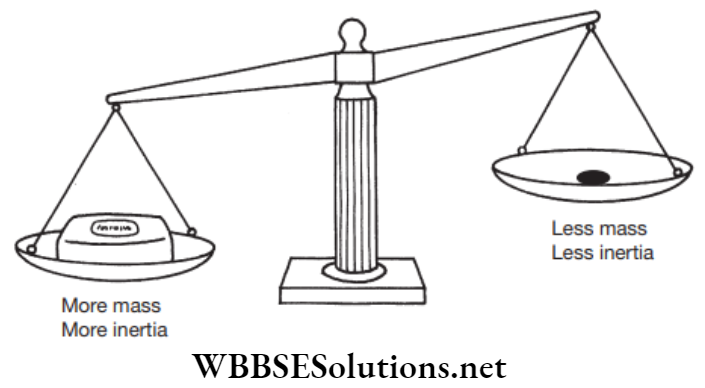
Chapter 3 Gravitation Weight
The weight of an object is the force with which the earth attracts it towards its centre. Weight is a vector quantity. The S.I. unit of weight is Newton (N) and its C.G.S. unit is dyne 1 N = 105 dyne The weight of an object is also known as the force of gravity on that object.
Weight of an Object on the Moon
Weight of an object on the earth is the force with which the earth attracts the object. Similarly, the weight of an object on the moon is the force with which the moon attracts the object. Moon exerts less force of attraction than the earth because the mass of moon is lesser than the earth.
Mass of object = m
Weight of mass on moon = Wm
Mass of moon = Mm
Radius = Rm
As per universal law of gravitation, the weight of the object on the moon
Wm = \(G \frac{M_m m}{R_m{ }^2}\) (1)
Let the weight of same object on earth = We
Mass of earth = M
Radius of earth = R
Then We = \(G \frac{M m}{R^2}\) (2)
On substituting the known value in Eq (1) and (2), and comparing them, we find that
Weight of object on moon = 1/6 Weight of object on earth
Relationship between Weight and Mass
Weight = mass × Acceleration due to gravity
W = m × g
The gravitational unit of weight in M.K.S. system = Kilogram force (kgf)
C.G.S. unit is gramme force (gf)
1 kgf = 9.8 N
980 Dyne = 9.8 × 10-3 N
Chapter 3 Gravitation Very Short Question And Answers
Question 1. Define weight. Write its SI unit.
Answer:
Weight:
Weight of an object is the force with which earth attracts it towards its centre. SI unit of weight is Newton.
Question 2. The mass of an object is 120 kg on the surface of the earth. What would be its weight when measured on the surface of the moon? What would be its mass on moon? (Take g = 10 m/s2)
Answer:
Given:
The mass of an object is 120 kg on the surface of the earth.
Mass of an object on the earth, me = 120 kg
Acceleration due to gravity on the earth, ge = 10 m/s2
Weight of the object on the earth, We = ?
We = me × ge
By putting the value we get,
We = 120 kg × 10 ms-2
We = 1200 N
We know that the weight on the surface of moon is = (1/6) × its weight on the earth
We = 1/6 × 1200 N
We = 200 N
Question 3. An artificial satellite is moving in a circular orbit around the earth with a speed equal to half the magnitude of escape velocity from the earth.
- Determine the height of satellite above the earth’s surface.
- If satellite is stopped suddenly in the orbit and allowed to fall freely to the earth, find the speed with which it hits the surface of the earth.
Radius of earth = 6.4 × 106 m
Answer:
(1) Let M be the mass of the earth and R be its radius then escape velocity of earth is given by the equation
ve = \(\sqrt{\frac{2 G M}{R}}\)
For satellite of mass m and orbital radius r = R + h where h is the height of the satellite above the earth’s surface moving with speed v, we thus have
\(\frac{m v^2}{r}=\frac{G M m}{r^2}\)
v = \(\sqrt{\frac{G M}{(R+h)}}\)
or,
It is given that
v = \(\frac{v_t}{2}\)
From equation (1) and (2)
\(\frac{G M}{(R+h)}=\frac{G M}{2 R}\)
From this we calculate that R + h = 2R or h = R
(2) Total initial energy of the satellite at height h above the surface of earth is
Ei = K.E. at height h + PE at height h
Ei = \(=0-\frac{G M m}{(R+h)}=-\frac{G M m}{R+h}\)
As the satellite is stopped in its orbit, KE at height h = 0. Let be the speed with which the satellite hits the surface of the earth. The final energy at the surface of the earth is
Ef = K.E. at h = 0 + P.E. at h = 0 = \(\frac{m v^2}{2}-\frac{G M m}{R}\)
From principle of conservation of energy Ef = Ei i.e.,
\(\frac{1}{2} m v_0^2-\frac{G M m}{R}=-\frac{G M m}{(R+h)}\)
From above equation we can calculate v0 which is
v0 = \(\sqrt{G M / R}\)
Now acceleration due to gravity on the surface of earth is given by
g = \(\frac{G M}{R^2} \text { or } \frac{G M}{R}=g R\)
Putting this in equation (3) and calculating we get
v0 = 7.92 × 103 m/s
Chapter 3 Gravitation Thrust and Pressure
Thrust
A force can be applied on a surface in any direction. If a force is applied on a surface in a direction normal or perpendicular to the surface, it is called thrust. The effect of thrust depends on the area of surface on which it acts. The effect of a thrust is less on a large area and vice versa.

Thrust exerted by an object on a surface is the force that object exerts on the surface which is equal to the weight of that object. Thrust is a vector quantity.
Unit
The S.I. unit of thrust = Newton (N)
C.G.S. unit of thrust = Dyne
Gravitational unit of thrust in M.K.S. system = kgf
Gravitational unit of thrust in C.G.S. system = gf
1 kgf = 9.8 N
1 gf = 980 dyne
Pressure
Pressure is the thrust per unit area of the surface. Pressure is a scalar quantity.
Pressure = \(\frac{\text { thrust }}{\text { Area }}\)
\(P=\frac{F}{A}\)
Factors Affecting the Pressure
The pressure exerted on a surface depends on two factors
- Thrust
- Area on which the thrust is applied
Unit
The S.I. unit of pressure = \(\frac{\text { Newton }}{\text { metre }^2}=\frac{\mathrm{N}}{\mathrm{m}^2}=\text { pascal }\)
Symbol of pascal = Pa
C.G.S. unit = dyne/cm2
1 dyne/cm2 = 0.1 N/m2
1 N/m2 = 10 dyne/cm2
1 bar = 105 N/m2
1 millibar = 10-3 bar = 102 N/m2
Pressure in Fluids
Any substance that can flow is called a fluid. Therefore, all liquids and gases are fluids. As we know solid exerts pressure on a surface due to its weight. Similarly, a fluid exerts pressure due to its weight.
We have studied that a solid exerts pressure on the surface but liquid exerts pressure at all points and in all directions. It exerts pressure at the bottom and also on the sides of the container.
Factors Affecting the Pressure at a Point in a Liquid
The pressure at a point inside the liquid depends directly on the following factors:
- Depth of the point below the free surface (h)
- Density of liquid (d)
- Acceleration due to gravity (g) at that place.
So, pressure at a point due to a fluid is given by
P = h × d × g
Laws of Liquid Pressure
- Pressure at a point inside liquid increases with the depth from its free surface.
- In a stationary liquid, pressure is same at all the points on a horizontal plane.
- Pressure is same in all the directions about a point in liquid.
- Pressure at same depth is different in different liquids. It increases with the increase in density of liquid.
- A liquid seeks its own level.
Buoyancy
When an object is partially or completely immersed in water, an upward force acts on it. This upward force is known as buoyancy. Another name of this force is buoyant force or upthrust. It is denoted by the symbol FB.
The property of a fluid to exert an upward force on a body immersed in it is called buoyancy.
Why Objects Float or Sink when Placed on the Surface of Water?
To understand it let us take an example. Take an empty closed bottle and dip it in a vessel filled with water. You will notice that most of the part of the bottle is floating above the water level. Now push the bottle, an upwardforce will be felt. As we try to push the bottle inside water, we need to apply more and more force to dip it completely inside the water.
Even after it is completely dipped in water, force is required to let it remain there. As soon as we remove the force, the bottle will come up again and starts floating. This is due to upthrust of water.
Characteristic Properties of Upthrust
- Larger the volume of an object submerged in fluid, greater is the upthrust.
- For same volume inside the fluid, more the density of fluid, greater is the upthrust.
- The upthrust acts on an object in upward direction at the centre of buoyancy.
Factors Affecting the Upthrust
The magnitude of upthrust on an object due to liquid depends on the following factors
- Volume of object submerged in the liquid (V).
- Density of the liquid in which the object is submerged (dl) and
- Acceleration due to gravity (g) at that place.
Chapter 3 Gravitation Very Short Question and Answers
Question 1. Define one Pascal.
Answer:
Pascal:
One Pascal is the pressure experienced by the surface when 1 N force acts on 1 m2 area of the body.
Question 2. Give characteristics of pressure inside fluids.
Answer:
Characteristics of pressure inside fluids:
A fluid contained in a vessel at the same level exerts equal pressure in all directions and on the walls of the container.
Question 3. What are the factors affecting the pressure at a point in a liquid?
Answer:
The pressure at a point inside the liquid depends on the following factors:
- Depth of the point below the free surface.
- Density of liquid
- Acceleration due to gravity.
Question 4. Describe the laws of liquid pressure.
Answer:
The various laws of liquid pressure are:
- Pressure at a point inside liquid increases with depth from the free surface.
- In a stationary liquid, pressure is same at all point in a horizontal plane.
- Pressure is same in all directions about a point in liquid.
- Pressure at same depth is different in different liquids. It increases with increase in density of the liquid.
Question 5. What do you mean by the term buoyancy?
Answer:
Buoyancy:
When an object is partially or completely immersed in a liquid an upward force acts on it. This upward force is known as buoyancy.
Question 6. A solid body of mass 150 g and volume 250 cm3 is put in water. Will the body float or sink?
Answer:
Here, mass of the body, M = 150 g
Volume of body, V = 250 cm3
Density of body,
\(d=\frac{M}{V}=\frac{150 \mathrm{~g}}{250 \mathrm{~cm}^3}=0.6 \mathrm{~g} / \mathrm{cm}^3\)
Since the density of the body is less than the density of water which is 1 g/cm3 the body will float on water.
Chapter 3 Gravitation Fill In The Blanks
Question 1. The upward force acting onthe object immersed in liquid is known as ________.
Answer. Buoyancy
Question 2. ___________ is the force acting on a body normal to the surface.
Answer. Thrust
Question 3. A fluid contained in a vessel exerts a pressure at all points and in all directions. (True/False)
Answer. True
Question 4. The pressure experienced by a large surface area will be _________.
Answer. Less
Chapter 3 Gravitation Archimedes’ Principle
When an object is immersed in a liquid, it occupies the space that was earlier occupied by the liquid. Volume of liquid displaced by the object = Volume of submerged part of object
Therefore, the object experiences an upthrust which is equal to the weight of the liquid displaced.
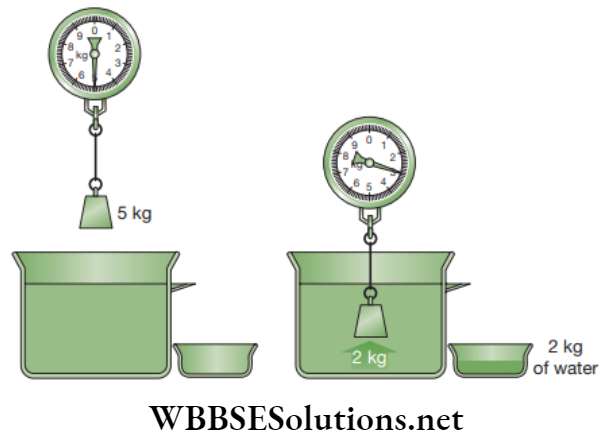
Archimedes’s Principle States
When an object is immersed in a liquid partially or completely, it experiences an upthrust, which is equal to the weight of liquid displaced by it.
Illustration
In the a metallic piece is suspended with the help of a thread, from the hook of a spring balance. Note its weight. Now, take a vessel and fill it with water. Keep a measuring cylinder next to the vessel. Now dip the metallic piece inside the water.
Some water will get collected in the measuring cylinder. Now note the weight of the solid and also measure the volume of water in the measuring cylinder.
The density of water is 1 g/cm3, the volume of collected water in the measuring cylinder is equal to the mass in g or weight in gf of the water displaced by the solid when solid is completely dipped inside water.
It is found that the weight of water displaced by the solid is equal to the loss in weight of the solid in water. Loss in weight of the body is due to upthrust. So, upthrust is equal to weight of water displaced by the body. This verifies Archimedes’ Principle.
Chapter 3 Gravitation Relative Density
We have already studied that density of a substance is its mass per unit volume.
\(\text { Density }=\frac{\text { mass of the substance }}{\text { volume of the substance }}\)
Relative Density (R.D.) of a substance is the ratio of the density of that substance to the density of water at 4 °C.
\(\text { Relative Density }=\frac{\text { density of substance }}{\text { density of water at } 4^{\circ} \mathrm{C}}\)
= \(\frac{\text { mass of unit volume of substance }}{\text { mass of unit volume of water at } 4^{\circ} \mathrm{C}}\)
= \(\frac{\text { mass of substance }}{\text { mass of equal volume of water at } 4^{\circ} \mathrm{C}}\)
Relative density of a substance is defined as the ratio of mass of the substance to the mass of an equal volume of water at 4°C.
Unit
As it is a pure ratio it has no unit.
Chapter 3 Gravitation Very Short Question and Answers
Question 1. What do you mean by Archimedes’ principle?
Answer:
Archimedes’ Principle:
When an object is immersed in a liquid partially or completely, it experiences an upthrust which is equal to the weight of the liquid displaced by it.
Question 2. State 2 uses of Archimedes’ principle.
Answer:
The uses of Archimedes’ principle are:
- It is used in designing submarines and ships.
- It is used in lactometers, which is used to determine the purity of milk.
The mass of an empty bucket of capacity 10 litres is 1 kg. Find its mass when completely filled with a liquid relative density 0.8.
Answer:
Here, mass of empty bucket,
m = 1 kg
Volume of bucket,
V = 10 litres = 10 × 10-3 m3 = 10-2m3
Relative density of liquid,
R.D. = 0.8
R.D. = density of liquid/density of water
0.8 = d/1000 kg/m3
d = 0.8 × 1000 kg/m3
d = 800 kg/m3
Mass of liquid in bucket,
M = V × d
M = (10-2m3) × (800 kg/m3)
M = 8 kg
Total mass in bucket = m + M = 1 kg + 8 kg = 9 kg
Chapter 3 Gravitation Fill in the Blanks
Question 1. The Earth’s speed is ______ when it is closer to the Sun.
Answer. more
Question 2. The orbit of Earth around the Sun is ______.
Answer. elliptical
Question 3. The acceleration due to gravity depends on mass and ______ of the planet.
Answer. radius
Question 4. The weight of object in water is called its ______.
Answer. apparent weight
Question 5. Weight of a body on Earth = ______ times the weight of a body on Moon.
Answer. six
Question 6. To increase the gravitational force between two bodies, the distance between them must be ______.
Answer. decreased
Question 7. A stone goes up in the air due to ______.
Answer. kinetic energy
Question 8. ‘G’ is the ______ gravitational constant.
Answer. universal
Question 9. Water exerts force on a submerged stone in the ______ direction.
Answer. upward
Question 10. Weight of a body is ______ when measured underwater.
Answer. less
Chapter 3 Gravitation Match the Columns
Question 1. Choose the correct unit.
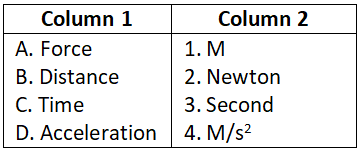
Select the correct option:
- A-1, B-2, C-3, D-4
- A-4, B-3, C-2, D-1
- A-2, B-1, C-3, D-4
- A-2, B-3, C-1, D-4
Answer. 3. A-2, B-1, C-3, D-4
Question 2. Choose the correct unit.
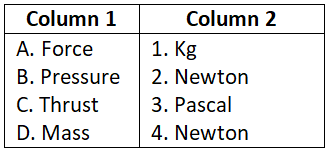
Select the correct option:
- A-1, B-2, C-3, D-4
- A-4, B-3, C-2, D-1
- A-2, B-1, C-3, D-4
- A-2, B-3, C-1, D-4
Answer. 2. A-4, B-3, C-2, D-1
Question 3. Choose the correct nature of the physical quantities.
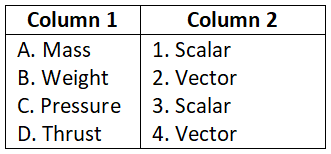
Select the correct option:
- A-1, B-2, C-3, D-4
- A-4, B-3, C-2, D-1
- A-2, B-1, C-3, D-4
- A-2, B-3, C-1, D-4
Answer. 1. A-1, B-2, C-3, D-4
Question 4. Choose the correct equation.
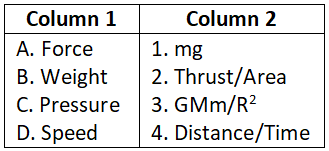
Select the correct option:
- A-1, B-2, C-3, D-4
- A-4, B-3, C-2, D-1
- A-2, B-1, C-3, D-4
- A-3, B-1, C-2, D-4
Answer. 4. A-3, B-1, C-2, D-4
Chapter 3 Gravitation Assertion Reasoning
Direction: For the following questions the options will remain the following:
- Both A and R are correct and R is correct explanation of A.
- Both A and R are correct but R is not a logical explanation of A.
- A is correct but R is incorrect.
- R is correct but A is incorrect.
- Assertion: Relative Density has no unit.
Reason: It is a unit.
- Assertion: The liquid will flow out from the holes of the vessel.
Reason: This is because liquid exerts pressure on the wall of the vessel.
- Assertion: Weight is a scalar quantity.
Reason: Force can be applied towards earth and in opposite direction.
Chapter 3 Gravitation Comprehension Passage
Sir Issac Newton was born in 1642 in Woolsthorpe near Grantham, England. He belonged to a poor family. His interest was not into farming, Instead, he went for studies to Cambridge University in the year 1661.
In the year 1665, the incident of falling apple happened. This incident made him think about the gravity of force which intact moon in its orbit. This gave birth to the invention of universal law of gravitation. He was the first person to discover about gravity.
Newton gave laws of motion. Along with it he worked on light and colour. To do observations on astrology, he designed an astronomical telescope. He was good in mathematics so and invented calculus.
Question 1. In which year Issac Newton was born?
- 1662
- 1642
- 1622
- 1602
Answer. 2. 1642
Question 2. In which year did apple fall on Newton’s head?
- 1642
- 1662
- 1665
- 1675
Answer. 3. 1665
Question 3. Who invented universal law of gravitation?
- Issac
- Newton
- Issac Newton
- Alberto
Answer. 3. Issac Newton
Question 4. In which country was Issac newton born?
- England
- Germany
- London
- India
Answer. 1. England
Question 5. Which branch of mathematics was invented by Issac Newton?
- Integer
- Algebra
- Boolean
- Calculus
Answer. 4. Calculus
Chapter 3 Gravitation Integer Type Question And Answers
Question 1. A ball is thrown vertically upwards and rises to a height of 10 m. Calculate the velocity with which the object was thrown upwards.
Answer. 14 m/s
Question 2. What is the magnitude of the gravitational force between the earth and a 1 kg object kept on its surface? (Mass of the earth is 6 × 1024 kg and radius of the earth is 6.4 × 106 m).
Answer. 10N
Question 3. Gravitational force on the surface of the moon is only as strong as gravitational force on the earth. What is the weight in Newton of a 10 kg object on the moon and on the earth?
Answer. Weight of body on earth = 100N, Weight of body on moon = 17N
Question 4. A stone is thrown vertically upward with an initial velocity of 40 m/s. Taking g = 10 m/s2, find the maximum height reached by the stone. What is the net displacement and the total distance covered by the stone?
Answer. Height = 80m, Total distance travelled = 160m, Total displacement = 0
Question 5. A ball thrown up vertically returns to the thrower after 6 s. Find (1) the velocity with which it was thrown up, (2) the maximum height it reaches, and (3) its position after 4 s.
Answer.
(1) Velocity = 30m/s
(2) 45m
(3) 40m above ground
